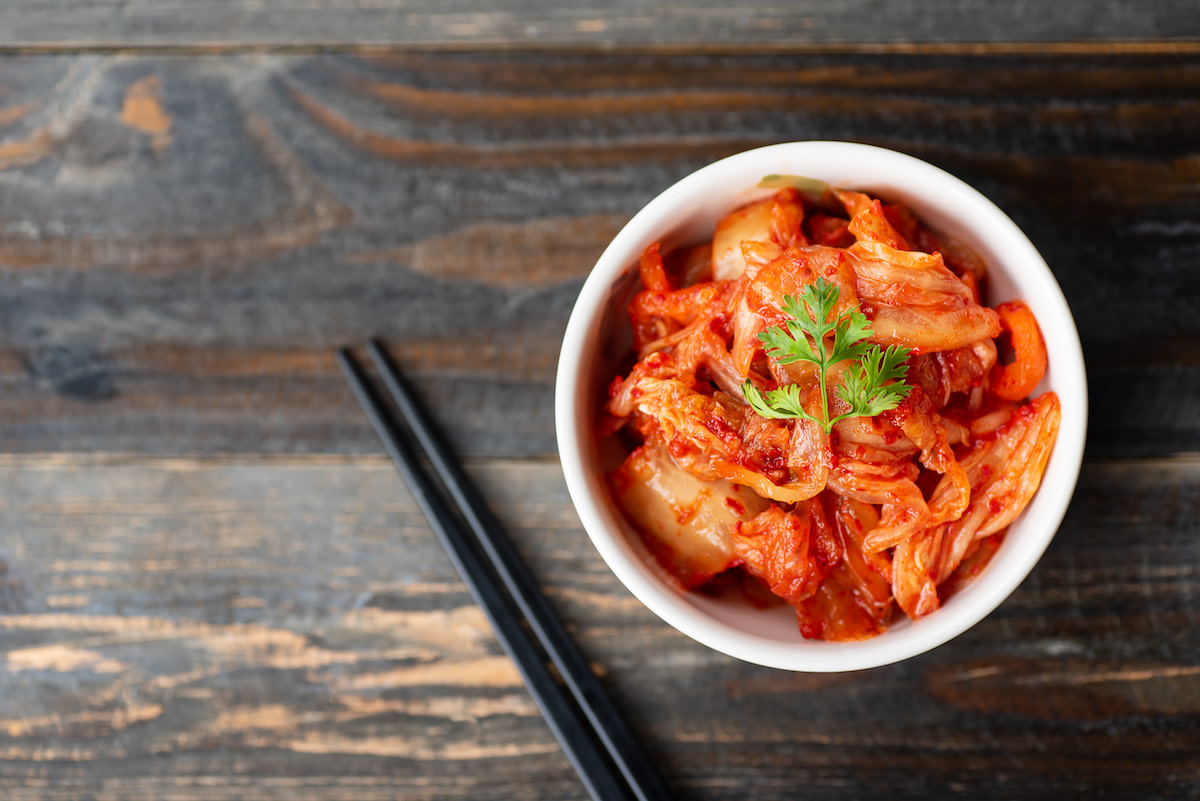Etymology [ edit ]
by Admin
Posted on 15-10-2023 12:56 PM

Etymology[ edit ]
borrowed from korean 김치 (gimchi), ultimately composed within korea of chinese -derived morphemes 沉 (mc drim, “submerged, soaked”) and 菜 (mc tshojh, “vegetable”), i. E. "fermented vegetable". Doublet of kimuchi. Kimchi
kimchi (usually uncountable , plural kimchis )
a korean dish made of vegetables, such as cabbage or radishes, that are salted, seasoned, and stored in sealed containers to undergo lactic acid fermentation.
 , pocket books, page 238:
2007, pamela goyan kittler, kathryn sucher,
food
and culture
, cengage learning, page 5:
2011, gerald m. Weinberg,
cantonese: 泡菜 (paau3 coi3)
chinese:
nominative
possessive forms of kimchi (type risti)
first-person singular possessor
kimchi in wielki słownik języka polskiego, instytut języka polskiego pan
kimchi in polish dictionaries at pwn.
, pocket books, page 238:
2007, pamela goyan kittler, kathryn sucher,
food
and culture
, cengage learning, page 5:
2011, gerald m. Weinberg,
cantonese: 泡菜 (paau3 coi3)
chinese:
nominative
possessive forms of kimchi (type risti)
first-person singular possessor
kimchi in wielki słownik języka polskiego, instytut języka polskiego pan
kimchi in polish dictionaries at pwn.
History [ edit ]
Fermentation has been part of human diet since the prehistoric times. Kimchi is a korean culinary tradition with a 1,500 year recorded history, developed as a means to preserve cabbage and other vegetables naturally through fermentation—like its distant cousin sauerkraut, or brined pickles.
 There is a certain mythical aura to kimchi if you ask any koreans. Long heralded as the “super food” of korea, many studies and findings in recent years associate kimchi’s unique attributes to numerous health benefits. Kimchi produces non-dairy probiotics, or “healthy bacteria,” that aids in digestion and building a healthy, balanced gut flora, which results in a stronger immune
system
.
There is a certain mythical aura to kimchi if you ask any koreans. Long heralded as the “super food” of korea, many studies and findings in recent years associate kimchi’s unique attributes to numerous health benefits. Kimchi produces non-dairy probiotics, or “healthy bacteria,” that aids in digestion and building a healthy, balanced gut flora, which results in a stronger immune
system
.
See also [ edit ]
If you’re into salty, less tangy fresh kimchi, you can go ahead and dig in, but fans of funky-acidic fermented kimchi should stuff the cabbage in a jar ( fermenting jars are your friend here: they let gas escape without letting in dangerous bacteria), seal it up, and stash it in a dark and shady place. A full-blown kimchi fridge is a good choice for hardcore kimchi aficionados ; otherwise, a cool corner of your kitchen will do just fine. Once again, cho says the final fermentation time depends on the temperature outside and how funky you want to ferment your kimchi — in warmer days, the fermentation kicks in in 12 to 24 hours; in cooler weather, it can take two to three days.
Dishes usually served with kimchi [ edit ]
In korean culture, kimchi is served with almost every meal, including breakfast. Not only is kimchi eaten by itself as a side dish or appetizer but it is also used as an ingredient in a variety of dishes. Kimchi jjigae , a traditional stew made with kimchi, is perhaps one of its most popular uses. The fermented food is also used to flavor fried rice, stir-fry dishes, noodles, sandwiches, and even pizza.
We're making homemade kimchi in the chili pepper madness kitchen today, my friends. If you're spicy food lover, i'm certain that kimchi is already on your radar. Kimchi is a korean dish of spicy fermented vegetables, and extremely significant to korean cuisine. It is consumed in many ways throughout korea, tossed into fried rice dishes, ramen type dishes, served up as the star of the meal or nibbled on as a simple, healthy snack. Napa cabbage is more commonly used, though it can be made with many other vegetables. The process involves fermentation, which is the break down of foods by lactic acid bacteria in a salt brine.
Kimchi has been a staple food of korean cuisine for generations, with mentions of the dish dating back centuries. This fermented side dish of vegetables and spices is served alongside nearly every meal in korean households at home and abroad. The dish holds a special place for many koreans as a comfort food as well as a way to connect with korean identity and heritage. With a long history of sustaining koreans through harsh winters and difficult times, kimchi is one of those rare dishes that transcends its role as a humble side dish and has become an icon of korean culture and cuisine.
Kimchee is a traditional korean dish of fermented vegetables, the most common of which are napa cabbage and daikon radish. Kimchee is actually the national food of korea. And, it should be noted that the proper spelling of kimchi is “kimchee. ” in this post, i occasionally refer to it as kimchi, but that is the japanese spelling for this beloved korean dish. In addition to being served as banchan, korean side dishes presented as part of a meal, it can also be used in a variety of cooked dishes like kimchi fried rice or kimchi quesadillas. I love topping these korean (bulgogi) beef tacos with it – they’re amazingly delicious!.